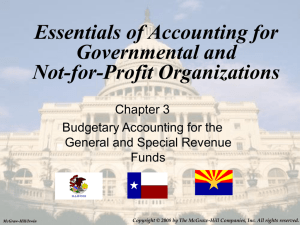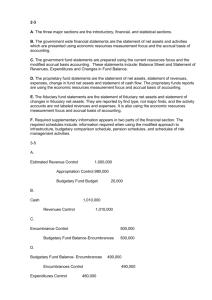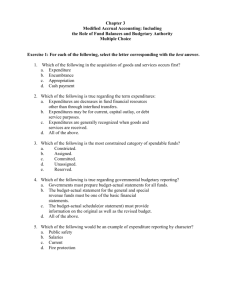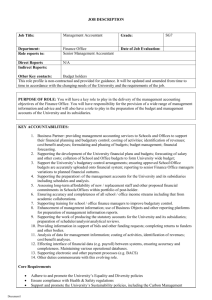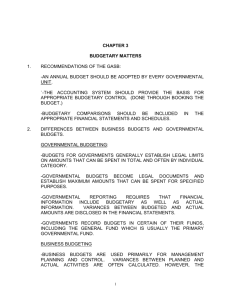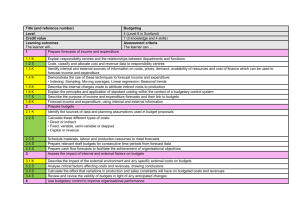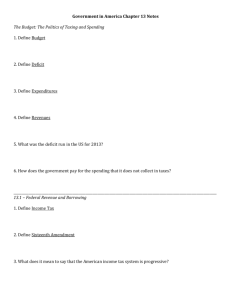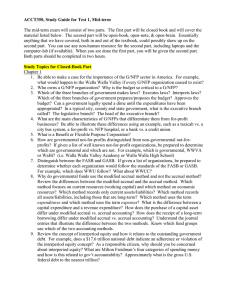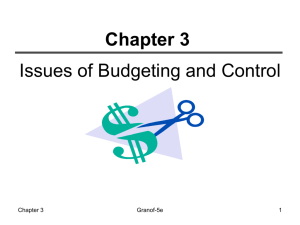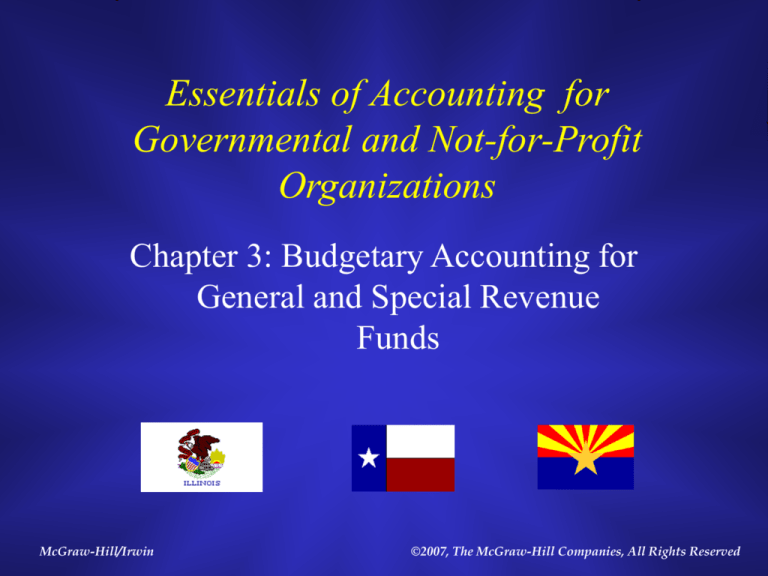
Essentials of Accounting for
Governmental and Not-for-Profit
Organizations
Chapter 3: Budgetary Accounting for
General and Special Revenue
Funds
McGraw-Hill/Irwin
©2007, The McGraw-Hill Companies, All Rights Reserved
3-2
Overview of Chapter 3
• Importance of budgets in government
accounting
• Recording the budget in the accounts
• Overview of property taxes
• Interfund transactions and other financing
sources
3-3
Importance of Budgets
• Net income is NOT a good measure of
government effectiveness
– Excess of revenue over expenditure does
NOT mean success, but indicates whether the
funds received are in excess of the funds
expended
– Since the funds received are often the result
of nonexchange transactions, Tax Revenues
are not equivalent to Sales as a measure of
success in the marketplace
3-4
What is the Budget?
• A budget is a financial plan submitted to
the appropriate body for approval
• Once approved, budgets carry the status
of law
– When voted upon, an appropriation act
gives the legal authority to spend and
generally sets the maximum limit for
spending
3-5
Importance of Budget Reporting
• The primary means of financial control by
the government is the budget
– The financial report should answer the question
-- Did the government use its funds as
promised?
– Budget amounts are incorporated in accounting
records of the General Fund and special
revenue funds to provide information that will
keep spending within the legal limits
3-6
Uses of Budgets
• Governments must adopt an annual budget
• General funds and Special Revenue funds
will have separate budgets . Separate
budgets are optional for other governmental
funds and are not used for proprietary and
fiduciary funds.
• Budgetary accounting principles are the
same for any governmental type fund which
adopts an annual budget
3-7
The General Process of Putting
Together a Budget
• Plan the expected inflows
– Project revenues based on past history, economic
models, etc
• Plan the expected outflows
– Ask departments for their projected needs
• Balance the inflows and the outflows
– Look for places to increase revenues or to cut spending
– Governments may also borrow or use accumulated
surpluses to balance inflows and outflows
3-8
Budgetary Accounting - New
Account Titles
• Estimated Revenues
– Budgeted inflows -- debit balance
• Appropriations
– Budgeted spending -- credit balance
• Encumbrances
– Commitments (e.g. purchase orders) outstanding -reminding ourselves we have entered a commitment for
a future expenditure -- debit balance
• Reserve for Encumbrances
– Restriction on fund balance -- credit balance
3-9
Recording the Budget
• Assume $1,000,000 of revenues are budget
along with $950,000 of estimated
expenditures
– The budget entry would be
• Estimated Revenues 1,000,000
•
Appropriations
•
Budgetary Fund Balance
950,000
50,000
• Alternatively, estimated revenues and appropriations
could be recorded in separate entries
3-10
Incorporating Other Financing
Sources and Uses in Budget Entry
• Assume a city budgets property tax revenues of
$2,000,000; bond proceeds of $1,000,000; expenditures of
$2,800,000; and a transfer to another fund of $100,000
• The budget entry would be
Estimated Revenues
Estimated Other Financing Source
Appropriations
Estimated Other Financing Use
Budgetary Fund Balance
2,000,000
1,000,000
2,800,000
100,000
100,000
3-11
Why Record Encumbrances?
• In business accounting, orders are not
entered into the general ledger
• Governments recognize that an
outstanding order will turn into an
expenditure and a liability when the
goods arrive
• To prevent over-spending outstanding
orders are entered into the books
3-12
Recording Outstanding Orders
• Place an order for $150,000 which consists of three
mini-buses costing $50,000 each. Recorded as:
Encumbrances
150,000
Budgetary FB Res. for Encumb.
150,000
• Assume two of the buses arrive, but with freight, they
cost $102,000 instead of $100,000.
– First, reverse a part of the encumbrances:
Budg. FB Res. for Encumb.
Encumbrances
100,000
100,000
– Second, record the actual amount of expenditure:
Expenditure
Accounts Payable
102,000
102,000
3-13
Budget Revisions
• Budget revisions may be
necessary during the
year due to changes in
revenue projections or
operating conditions …
for example, electricity
price increases, decrease
in sales taxes due to low
consumer spending
• Budget revisions usually
are taken back to the
appropriate legislative
body for approval,
although some
jurisdictions may allow
some percentage of the
budget to be transferred
between accounts
3-14
Budgetary Comparison Schedule
• Both the original and the final adjusted
budget is shown
• The revised appropriations are compared
to the Actual Expenditures for the current
period plus Outstanding Encumbrances
• A variance column is typically shown,
but is optional
3-15
Budgetary Comparison Schedule
• The actual column
should use the basis of
accounting assumed in
the budget. This may
be different than
GAAP basis
• Another schedule will
reconcile the ‘actual’
figures on the
budgetary vs. GAAP
basis
3-16
Classification of Inflows and
Outflows on Budget Schedule
• Revenues are classified by source
– Where the money came from: taxes, licenses and
permits, charges for service, etc
– May be subdivided further such as by type of tax,
sometimes shown in separate schedule
• Expenditures and Encumbrances may be classified
by
– function, program, department, activity, character,
or object
3-17
Outflow Classifications
• Examples of function: General government, public
safety, streets and highways
• Public safety could be subdivided by department:
Police and fire
• Police could be subdivided further by activity:
Traffic and drug enforcement
• Activities in the traffic area could be divided into
objects of expenditure: Policeman’s salary, gas for
automobiles
• Character groupings are always: CURRENT,
CAPITAL OUTLAY, and DEBT SERVICE
3-18
Property/ad valorem Taxes
• “Ad valorem” taxes are based on the
value of an underlying asset and are a
major type of tax, particularly at the local
government level
• All real property bought and sold is
typically registered at the county
courthouse and subject to property tax
• The tax is based on the tax rate, often
expressed as a millage rate, times the
assessed value
3-19
Property Taxes: 60 Day Rule
• Under modified accrual accounting,
property tax revenues may not exceed the
amount received during a fiscal year plus
the amount expected to be received during
the first 60 days after the end of the fiscal
year.
3-20
Millage and Assessed Value
• A mill is
– 1/1000 of a dollar, or 1/10 of a penny
– In other words, $.001 times some amount
• Appraised value
– Is calculated based on size of home, lot, etc.
– Ideally, should approximate market value
• Assessed value is usually less than
appraised value … often around 20% of
appraised value
3-21
Property Tax Calculation
• Assume a home has an appraised value
of $100,000; 20% assessed value rate;
tax rate is 45 mills
• Assessed value:
$100,000 X .20 = $20,000
• Tax amount would be:
45 mills X 20 thousands = $900
Or, $20,000 X .045 = $900
3-22
How Is the Millage Rate Set?
• In some areas all property taxes are
subject to a direct vote
• In other areas the property tax is
adjusted each year (subject to possible
maximum amounts) to meet expenditure
needs
• Illustration 3-5 presents a calculation to
determine the property taxes needed to
balance the budget

